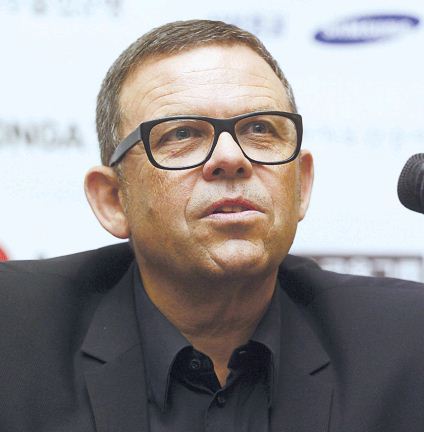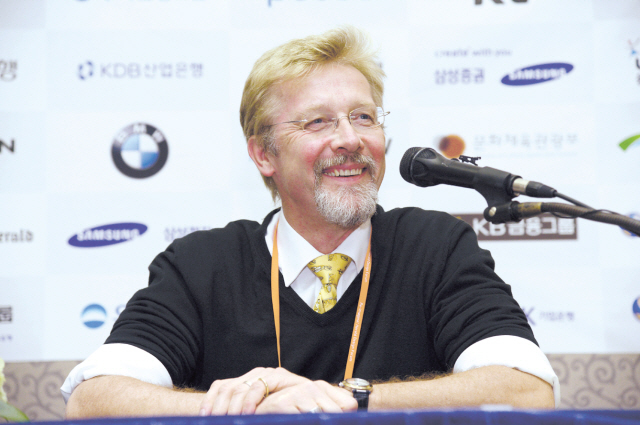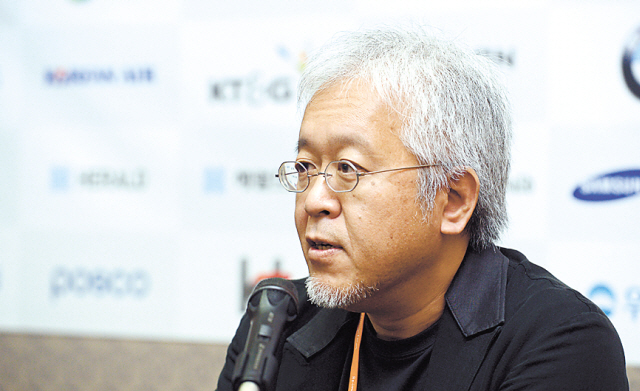
Top auto designers and architect talk about their design philosophies
Peter Schreyer may be best known for leading Audi to become a global premium car brand when he worked as chief designer for the carmaker from 1994 to 2002.
Now many Koreans recognize the German automotive veteran as the innovator who has brought freshness to Kia Motors cars, especially the K-series with its signature “tiger nose” radiator grille.
The chief design officer of Kia, who joined the company six years ago, hinted at the possibility of a new “tiger nose” during a press conference on Thursday.
“After the tiger nose comes the next tiger nose. This is going to stay. It’s a graphic icon that we want to keep so you can recognize KIA in the future,” he said at the Herald Design Forum held in Seoul.
Despite the success story of the flagship K-series, the K9, the lineup’s premium model launched in May, is suffering from lackluster sales here. Schreyer acknowledged the challenge but seemed unbothered.
“I think you need to be a little bit patient and give a little time to establish Kia in this kind of segment. I’ve gone through this process with two other companies (Audi and Volkswagen), stepping up into the segment,” he said.
He said Kia will continue going global with its cars. To do so the carmaker must appeal to a variety of customers, he said.
“If you find a good design, it should work well for Chinese customers, American customers. I want to make just a good product in technology and innovation. Then it will be successful anywhere,” he said.
Peter Schreyer may be best known for leading Audi to become a global premium car brand when he worked as chief designer for the carmaker from 1994 to 2002.
Now many Koreans recognize the German automotive veteran as the innovator who has brought freshness to Kia Motors cars, especially the K-series with its signature “tiger nose” radiator grille.
The chief design officer of Kia, who joined the company six years ago, hinted at the possibility of a new “tiger nose” during a press conference on Thursday.
“After the tiger nose comes the next tiger nose. This is going to stay. It’s a graphic icon that we want to keep so you can recognize KIA in the future,” he said at the Herald Design Forum held in Seoul.
Despite the success story of the flagship K-series, the K9, the lineup’s premium model launched in May, is suffering from lackluster sales here. Schreyer acknowledged the challenge but seemed unbothered.
“I think you need to be a little bit patient and give a little time to establish Kia in this kind of segment. I’ve gone through this process with two other companies (Audi and Volkswagen), stepping up into the segment,” he said.
He said Kia will continue going global with its cars. To do so the carmaker must appeal to a variety of customers, he said.
“If you find a good design, it should work well for Chinese customers, American customers. I want to make just a good product in technology and innovation. Then it will be successful anywhere,” he said.

Chris Bangle, another automotive design legend, believes that design philosophies of a company “unify on a mental level” without necessarily sharing common design elements.
“It’s quite a challenge for a company as diverse as Samsung and others to have an overriding design philosophy but I think they do,” Bangle said at the Herald Design Forum press conference.
“If the design philosophy and experience of your company is giving good value to the customers, exciting emotional experience, providing pleasure, then it does not matter what kind of a product it is. They unite on a higher level.”
Citing the example of BMW motorcycles and automobiles, and how the designs of the company’s two product branches are developed to be true to the brand without even sharing common elements, Bangle said that visual elements are not necessarily the key to creating a design philosophy.
Since leaving the automotive industry in 2009, the former BMW Group chief of design has been running his own company, Chris Bangle Associates. Through the company he has expanded into various industries including electronics and sports wear.
Among the more notable clients of Chris Bangle Associates is Samsung Electronics, for which Bangle has been working as an outside consultant while performing the duties of the electronics giant’s master designer.
In Japanese designer Kenya Hara’s view, Asia’s traditional heritage can be a great future resource.

Hara, who serves as Japanese retail company MUJI’s art director, as well as the representative of the Nippon Design Center, said he is interested in creating design that reflects Asia’s traditional values and culture, during a press conference on Thursday.
“There are many resort hotels in Asia, for example,” Hara told reporters.
“And most of the buildings in these resorts are built like the ones in the West. Many of the resorts have Western restaurants, having their waiters and waitresses dressed in white uniforms, serving Bordeaux wine.
“But we Asians have a very different perspective on nature, vacations and how we spend our time and space,” he continued.
“Most of us are not used to taking a long break. I’m interested in the idea of designing resort hotels that reflect such perspectives and (traditional values), using modern technology and design.”
During his lecture earlier in the day, Hara said he has been particularly impressed by Korea’s traditional houses “hanok,” and their heating system “ondol.” He said it is a “required task” for designers of the current generation in Asia to create ways to incorporate its traditional sentiments and philosophy for designs in future. Ondol, in particular, could be transformed into a new, sustainable heating system if complemented with today’s high technology, he said.
By Lee Ji-yoon, Choi He-suk and Claire Lee
(jylee@heraldcorp.com)
(cheesuk@heraldcorp.com)
(dyc@heraldcorp.com)
-
Articles by Korea Herald


















![[KH Explains] Hyundai's full hybrid edge to pay off amid slow transition to pure EVs](http://res.heraldm.com/phpwas/restmb_idxmake.php?idx=652&simg=/content/image/2024/04/18/20240418050645_0.jpg&u=20240418181020)

![[Today’s K-pop] Zico drops snippet of collaboration with Jennie](http://res.heraldm.com/phpwas/restmb_idxmake.php?idx=642&simg=/content/image/2024/04/18/20240418050702_0.jpg&u=)